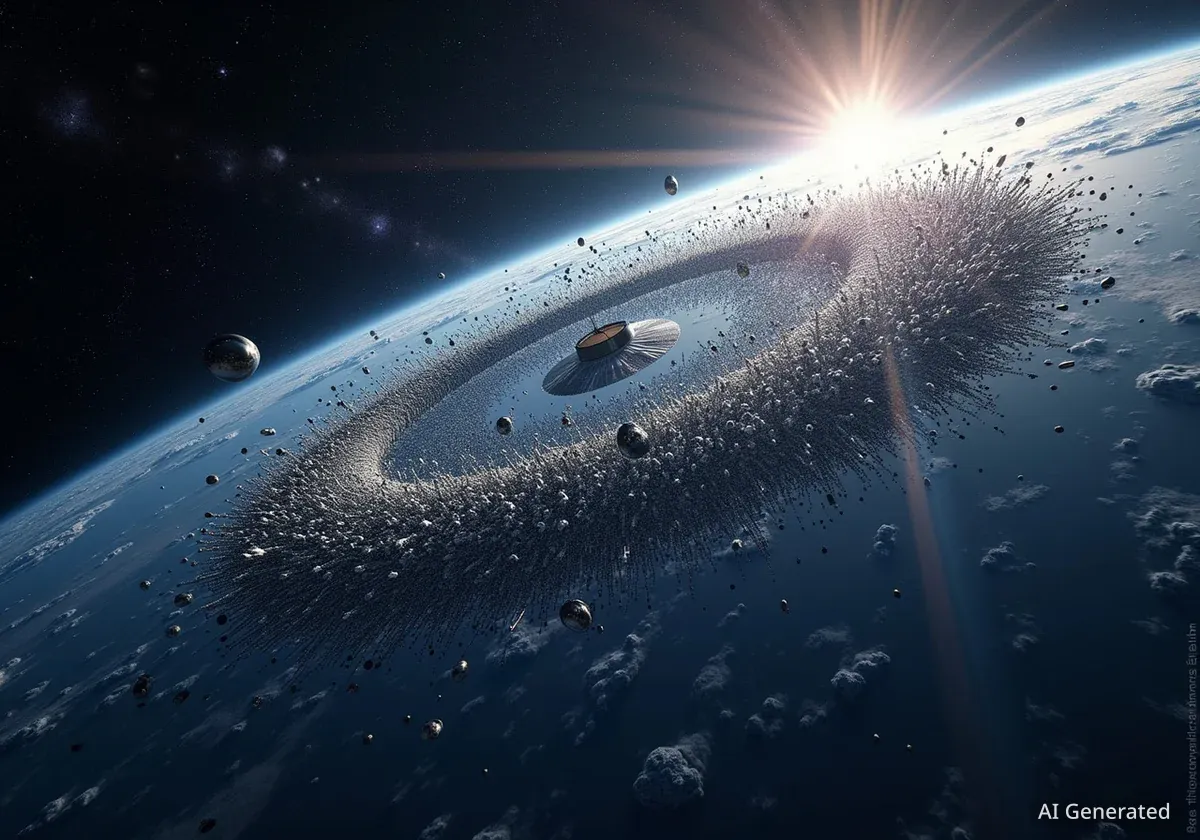The European Space Agency (ESA) has introduced a new system to measure the health of Earth's orbital environment, revealing that current space activity is four times beyond the threshold for long-term sustainability. The new Space Environment Health Index aims to provide a clear, single score to track the growing problem of space debris.
This new metric functions like a report card for space, grading the impact of satellites and debris on the safety and usability of orbits. With the rapid increase in satellite launches, particularly large constellations, officials warn that urgent action is needed to prevent key orbits from becoming unusable.
Key Takeaways
- ESA has launched the Space Environment Health Index, a single-score metric to assess the sustainability of Earth's orbit.
- The current orbital environment scores a 4 on the index, where a score of 1 represents the baseline for long-term sustainability.
- The index considers factors like a satellite's size, orbital lifetime, and collision avoidance capabilities to determine its environmental impact.
- This tool is designed to support policy-making, mission licensing, and ESA’s own Zero Debris initiative, which aims for zero debris from its missions by 2030.
A New Standard for Orbital Sustainability
For years, scientists have warned about the growing congestion in low-Earth orbit. To address this, the ESA has developed the Space Environment Health Index, a tool designed to simplify a complex problem into a single, understandable number. The goal is to create a universal language for discussing the consequences of our actions in space.
"The space environment health index is an elegant approach to link the global consequences of space debris mitigation practices to a quantifiable impact on the space debris environment," said Stijn Lemmens, a space debris mitigation analyst at ESA. He emphasized that the new metric helps make the consequences of space activities more concrete.
The index provides a framework for evaluating individual missions, much like an energy-efficiency rating for a household appliance. In the future, a mission could receive a sustainability rating, giving operators and regulators a clear benchmark for responsible behavior.
How the Health Index Works
The index score is calculated based on a mission's potential to create debris and increase collision risk over a 200-year period. A higher score signifies a greater negative impact, while a lower score indicates a more sustainable approach. Several key factors are considered for each object launched into space:
- Size and Shape: Larger objects pose a greater risk upon collision or fragmentation.
- Orbital Lifetime: How long an object will remain in orbit before it is removed or naturally re-enters the atmosphere.
- Maneuverability: The ability of a satellite to perform collision avoidance maneuvers.
- End-of-Life Safety: Whether an object has been properly passivated to prevent explosions after its mission is complete.
- Fragmentation Risk: The overall likelihood that an object will break apart and create more debris.
Defining the Baseline
The index's sustainability threshold of '1' is based on the 2014 guidelines from the Inter-Agency Space Debris Coordination Committee (IADC). These guidelines were established before the recent surge in large satellite constellations, representing what was considered a 'healthy' space environment at the time.
A Worsening Environmental Score
The latest assessment using the new index reveals a troubling picture. The current health of Earth's orbit is rated at level 4, which is four times higher than the sustainability benchmark. This indicates a significant and growing risk to current and future space operations.
Even in 2014, projections showed that the future orbital environment was on track to be three times riskier than the minimum desirable level. Today, with thousands more satellites and a corresponding increase in debris, that risk has escalated further.
Despite increased awareness and the adoption of mitigation practices by many operators, the overall situation has continued to deteriorate. The ESA's report suggests that stronger, more unified action is required to reverse this trend and protect humanity's future in space.
The Urgency of Now
While the most severe consequences are projected over a 200-year timeline, the problem requires immediate attention. Each new piece of debris adds to a cumulative risk that will persist for decades. A single fragmentation event can create thousands of new hazards, complicating space operations for generations.
Practical Applications for a Safer Future
The Space Environment Health Index is more than an academic exercise; it is intended as a practical tool for decision-making across the space sector. Its applications are expected to influence mission design, regulation, and international policy.
Francesca Letizia, a space debris mitigation engineer at ESA, highlighted its practical use. "We used the Health Index model to translate the mandate for a Zero Debris approach into numbers, identifying a path that would not exceed the orbital sustainability threshold," she explained.
"Even if the definition of the Health Index may seem very theoretical, at ESA we have already successfully applied this concept in practice."
From Design to Regulation
Engineers can use the index during the design phase of a mission to minimize its environmental footprint. By aiming for a low score, they can prioritize features like reliable deorbiting systems and robust collision avoidance capabilities.
Regulatory bodies could also adopt the index as a criterion for issuing licenses, ensuring that new missions meet a minimum sustainability standard before they are approved for launch. This could also influence the insurance industry, where risk assessment is critical.
Ultimately, the index provides a framework for transparency and accountability. By making sustainability measurable, it encourages collaboration and drives the entire space sector toward more responsible practices, safeguarding access to space for future generations.





